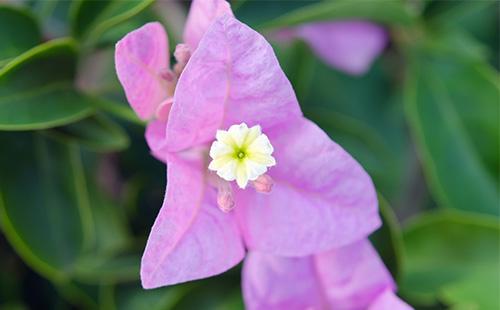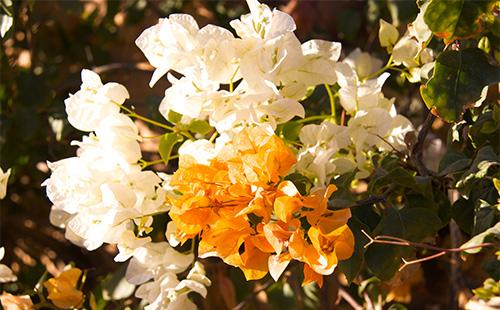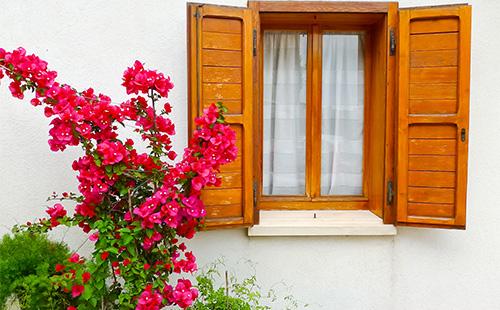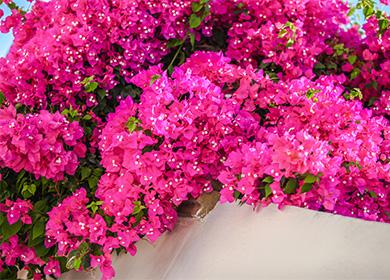The content of the article
Bougainvillea is a tropical guest. Her homeland is the moist forests of Brazil, hot South America. The plant got its name for a reason. The magnificent flower was brought to Europe by the French after their first round-the-world expedition. The campaign was led by Count de Bougainville, in whose honor a plant new to Europe was named. Although the European climate is a little like tropical, the flower quickly "accustomed". Bougainvillea has gained immense popularity in European gardening. Later, breeders raised indoor hybrids, although still exotic beauty can be seen more often on the streets than in the homes of Europeans.
If you are going to start bougainvillea at home, do not rush to contact the forum for tips or drive into a search engine: "bougainvillea care". Whether bougainvillea is suitable for the garden, how much it grows, why it drops leaves, how planting should take place, signs of improper care - our article with a photo and useful video will help to figure it out.
The popular name for bougainvillea is “paper flower”. And all because of bracts that resemble crumpled colored paper.
Botanical Description
Bougainvillea (Bougainvillea) - a representative of the family of nictagins. In nature, the plant is found in the form of small trees, shrubs, vines. The shoots of bougainvillea are covered with short and sparse spikes: with their help, they are attached to the support. Branches can stretch 5 m in length. Home hybrids are not so “creeping”, but you still have to do regular pruning, otherwise you can get real jungle on the windowsill.
The plant gained popularity due to the long flowering period: blooming in spring, bougainvillea blooms only in late autumn. If the climate is suitable for a tropical guest, she can delight in flowers for nine whole months.
- Flowers The beauty of bougainvillea is not in the flowers, but in the bracts. The flowers of the plant are small, inconspicuous. Inflorescences-brushes have a pale yellow color. Flowers quickly fade, but due to colorful bracts the plant does not lose its decorative attractiveness for a long time.
- Bracts. Large (up to 6 cm), bright bracts of various shapes for a long time please flower growers with their beauty. Bracts form a dense dome, beyond which branches and foliage are not visible. "Classic" bracts are purple, pink, red, but varieties with new shades are constantly appearing. Orange, white, cream bracts will not surprise anyone.
- Leaves. The plant has elongated and pointed leaves towards the end. Veins distinctly differ on the bedspread.The leaves are quite large - an average of 7 cm, however, they are covered by densely arranged bracts. The shade of foliage depends on the type of plant: in some shrubs, the leaves are light green, in others - dark emerald.
Popular views
Bougainvillea cannot boast of species diversity. Although there are a lot of varieties, there are only 14 species. Among them, flower growers distinguish three “favorites”.
- “Beautiful” (“Wonderful”). In Latin, the name sounds like Bougainvillea spectabilis. The plant has velvety leaves. The “beautiful” bougainvillea was called because of the very large bracts. There are multi-colored bedspreads, but always in the process of flowering they turn pale. Southerners love to decorate with this kind of gazebo.
- “Naked” (“Smooth”). The Latin name is Bougainvillea glabra. The peculiarity of this variety is glossy leaves, bright bracts. This bougainvillea was used in the first breeding.
- Peruvian. Or Bougainvillea peruviana. It is famous for blooming long and magnificent. It has dense spikes. Bracts are wrinkled, thin leaves. It differs from its relatives in that it branches poorly, but it grows very long shoots. Plants that are of this type need to be cut often. There is another way to maintain decorativeness: to lay branches, thereby creating a voluminous composition.
Caring for bougainvillea at home
The myth that bougainvillea is difficult to care for is very common among gardeners. Tropical guests are usually considered moody, however, this does not apply to the "paper flower". If you know how to care for bougainvillea in a pot, then there will be no difficulties: a grateful plant will bloom on the windowsill for a long time and luxuriantly.
Beginning gardeners need to remember the main secret: bougainvillea can not be rearranged. It is from “moving” that the plant withers away, and everything is attributed to the errors of care. If possible, put the pot on the southern windowsill. It is light and warm - everything, as a tropical guest loves. The plant needs circulating air, but drafts (especially cold) are dangerous.

Optimum temperature
The “paper flower" loves warmth. He feels comfortable in the summer when the temperature range ranges from 23 to 30 ° C. This mode stimulates flowering. In hot weather, it is better to take the plant to fresh air or at least provide regular and long-lasting ventilation.
In order for the plant to enter a dormant state, the temperature should not exceed 16 ° C, but this is difficult to achieve in an apartment, therefore on the windowsills of the bougainvillea usually blooms all year round. Some flower growers bring a tropical beauty to the balcony in cold weather to create conditions for peace, because continuous flowering can weaken the plant. However, we must not forget that a temperature below 7 ° C is detrimental to representatives of this family. Sudden temperature changes are best avoided - a “green friend” can get sick from them.
Lighting requirements
To grow and develop bougainvillea, you need good lighting. This is one of the few plants that really loves the sun, and not only loves, but needs it.A photophilous flower from March and inclusive to September needs a maximum of light, then flowering can be fully enjoyed. Direct sunlight is not afraid of the tropical "lady": daily bougainvillea must be in the open sun for at least three hours. But in the winter, when there comes a period of rest, the indoor plant will be comfortable in a shaded place.
Watering
Watering the "pet" is necessary with an eye on the season. In the spring-summer period, bougainvillea blooms, which means that it requires abundant watering. Allow the soil to dry out - the plant will drop flowers. Look for a "middle ground", because waterlogging is also undesirable. For irrigation, you need to take the settled water. Create a "tropical" conditions for the plant will help regular spraying. Use only soft water.
Caring for bougainvillea in winter involves a significant reduction in watering. You need to navigate the earthen coma. As soon as it dries, we water it. But it dries up - does not mean it dries out completely. Due to underfilling, you can lose the root system: it simply dries.

Top dressing
Feeding bougainvillea is a must. The plant should receive nutrients during the period of active growth, abundant flowering. Florists with experience recommend feeding a blooming tropical beauty once every two weeks. To do this, you can use organic or mineral fertilizers designed for flowering plants. If you have only complex ones at hand, you can use them, but it is important that the composition is designed specifically for decorative flowering plants. When a flower enters a dormant period, it is not necessary to feed it.
Cropping Features
Trimming bougainvillea is one of the most important stages of care. Novice flower growers are often unaware of the need for such a manipulation. As a result, the plant slows down growth, ceases to bloom and ... grows with myths about its moodiness.
The best time to trim is before waking up and before retiring. In the spring, you need to remove last year's shoots: they are halved. If you trim the bougainvillea correctly, it will bloom violently. Before wintering, shoots are removed by a third. During the period of active growth and flowering, pruning is aimed at maintaining the decorativeness of the plant: without cutting the shoots, the indoor flower will look messy. You need to cut off above the leaf or kidney, it is better to remove weak shoots. Be sure to remove faded shoots: thanks to this, side branches will form, on which, with proper care, flowers will still appear this season.
We change according to the rules
Bougainvillea does not like to be bothered. An adult plant does not need to be transplanted often: it is enough to change the “home” of a tropical beauty once every three years. However, if the soil in the flowerpot is thinned or the capacity becomes too small for the plant, it is better not to put it off. The young "pet" needs an annual transplant. It is possible less often, but usually the flower actively grows, and the pot becomes small for it. In order for the transplant to be successful and the “pet” has taken root in the new house, try to observe the following three rules.
- Pot. Choose a deep flowerpot so that the roots develop. A typical mistake is a pot for growth. The new container in diameter should be about 3 cm larger than the previous one. In an oversized flowerpot, the water will stagnate. If you plan to use the same container, you need to thoroughly wash it, and cut the roots of the plant so that they fit the pot in size.
- Drainage. In nature, the plant chose stony soils, so drainage is indispensable. Pour without sparing: the larger the plant, the greater the drainage layer.At the bottom of the pot you can lay expanded clay, crushed stone, broken brick, or use purchased drainage.
- Priming. Preference should be given to a specialized substrate from the store. But if there is no way to use it, prepare the soil yourself. To do this, mix sand, humus, turf and leafy soil in a ratio of 1: 1: 2: 2.

Breeding
An exotic plant can propagate in three ways: by cuttings, rooting of layering, and seeds. Seed propagation in indoor floriculture is not used: difficult, long and often inconclusive. This method involves pollination of flowers: in nature, butterflies do this, and with artificial pollination there is too much hassle. Moreover, there are two simple vegetative ways to get new plants.
Stem cuttings
- Separate the stalk from the adult plant.
- Treat it with a growth stimulator bought in a flower shop.
- Place the stalk in a bowl of sand and peat. The mixture should be wet.
- Make a greenhouse out of the bag. Put the container where there is a lot of light.
- It is better to plan the cuttings for the summer months: for successful rooting, a temperature of 25 ° C is needed.
Air layering
- Make an incision in the bark of the shoot. Only the escape that retains flexibility, has not yet managed to numb.
- Place a container of earth near the flowerpot. Bend the prepared shoot and fix it in the soil.
- When rooting occurs, separate the sprout from the “parent”.
Problems experienced by flower growers
When growing bougainvillea, flower growers often encounter various problems: lack of growth, drying of shoots, dumping of inflorescences. Bougainvillea is a grateful plant. If you take care of it correctly, transplant it in time, protect it from insects, then it will delight you with its beauty. If the appearance of the plant does not satisfy you, you need to look for the reason why bougainvillea has changed. Do not start the problem: the sooner measures are taken, the higher the chances of saving the plant.
Diseases and Pests
Bougainvillea, like any other plant, can get sick, it can be attacked by pests. Fortunately, this happens infrequently. But the owner of a tropical beauty needs to be alert, because the speed of the reaction depends on whether the "green pet" can recover. Diseases are treated with proper care, top dressing. Insecticides will help get rid of insects. The basic principles of treatment are described in the table.
Table - Diseases and pests: signs, treatment
| Pest, disease | Signs | Treatment |
|---|---|---|
| Aphid | - Bracts are deformed; - leaves are curled; - new shoots die | - Removal of affected areas; - spraying with insecticides ("Decis") |
| Spider mite | - The leaves turn yellow, crumble; - visible web on petioles | - “Bathing” in the shower; - exposure to cold (6-15 ° C); - treatment with drugs with "Permethrin"; - spraying with insecticides ("Kinmiks", "Admiral") |
| Mealy Tick | - Leaves turn yellow, fade; - white sticky fluff appears | - Wipe the leaves with a cotton pad dipped in soapy water; - spraying with insecticides designed to control powdery mites |
| Powdery mildew | - White coating on the leaves (if you do not react immediately, it will turn brown) | - Removal of affected areas; - dusting with sulfur; - treatment with drugs (for example, Bayleton) |
| Root rot | - Blackening of shoots; - leaf loss | - Removing rotten parts of the root system; - dusting of slices with crushed activated carbon; - treatment with a rooting agent; - change of substrate |
| Chlorosis | - Leaves brighten, may turn yellow; - white spots appear on the sheet | - Processing "Fitoferm"; - top dressing |
To prevent disease, you need to optimize plant care. Be sure to inspect the flower for parasites. We heard the first alarming “bell” - take the necessary measures.
Improper care
Most often, bougainvillea begins to languish when the rules of care are violated. Inadequate or excessive watering, too dry air, drafts, inappropriate substrate, lack of light - all this does not affect the condition of the plant in the best way. And do not forget that bougainvillea does not like changes: it can dry out from frequent changes and rearrangements of the flowerpot. The table below will be a hint for beginner gardeners and help you understand what went wrong.
Table - Problems in growing bougainvillea and their causes
| Problem | Possible reasons |
|---|---|
| Yellow leaves | - Waterlogged soil |
| Leaves or bracts fall | - Drafts; - lack of lighting; - redirection of shoots; - temperature change |
| Pale leaves and bracts | - Not enough nutrients; - bad light |
| Brown spots on the sheet blanket | - Low temperature combined with high humidity |
| The flower dries, the leaves turn black | - The soil mixture is overdried |
| Bracts are deformed | - Too dry air |
A plant that blooms year round looks worse than what rested. A long flowering period weakens bougainvillea. Experienced flower growers recommend sending a tropical guest for the winter forcibly: lowering the temperature in the room, shading the flower.
Why there are no flowers and how to fix it
Wait for the bloom of your "pet" - the best reward for the grower. Even novice lovers know that a weakened plant does not bloom. Top dressing will help weak bougainvillea grow stronger, and it will delight its inflorescences.
But if the plant looks healthy, grows actively, but does not want to bloom? The reason why bougainvillea does not bloom, if it is healthy, you should always look for in the care “gaps”.
The plant refuses to bloom when:
- excessive watering or drought;
- improper temperature conditions;
- inappropriate humidity;
- lack of light;
- incorrectly selected substrate;
- lack of nutrients.
A plant may change its mind about blooming in a flowerpot that is too big or small. If bougainvillea is not cut, then the flowers will also have to wait a long time. In a word, there are many nuances, but first of all you need to try to optimize the care.
Growing bougainvillea at home is not as difficult as is commonly believed. A flowering plant will not only decorate the house, but will also attract the necessary energy into it. Bougainvillea is considered a symbol of money: it directs cash flow to the home. Believe it or not is a purely personal matter.But in Asian countries, bougainvillea is used for landscaping financial institutions, and if you manage to grow a flower at home, the landlord is considered the lucky one who will have a comfortable life.
“It blooms and creates the feeling of an approaching vacation”, - reviews and tips
My bougainvillea is very tiny, it blooms and pleases more than grows, which does not upset me at all, such a compact beauty. Its maintenance is very simple, do not overfill, water when the earthen ball dries well, and provide a sunny place, after all, it is a guest of their hot countries, and the more sunny it is, the more comfortable it is, but it’s not worth it to “fry” for days, discard leaves . In summer, of course, it is more active, but if the necessary conditions are provided in winter, it will continue to please you with flowering and create a feeling of an approaching vacation!
You should not plant the plant in a spacious pot, otherwise the root system will develop more actively than the "top" - twigs and flowers, respectively. transplantation and transshipment is carried out only when the plant is well covered with an earthen lump!kat-malysh, http://irecommend.ru/content/bugenvilliya-privet-iz-zharkogo-schastlivogo-leta
I take it outside and there it stands until September, flowering is long. The room blooms poorly and the perianth is very pale.
Irishka https://forum.bestflowers.ru/t/bugenvillija.2102/
It grows on the western window, stands on a loggia from the very edge near the wall, upholstered by lining. The tree heats up in the sun and heats the flower. My bougainvillea is "fried" in the sun. It withstands overdry, it can be seen from it when it is time to water it: the leaves become limp and hang.
The earth has not changed her for about 5 years, blooms beautifully. Roots entangled in a pot so that not even a stick is stuck. There is no place for a larger pot, but I don’t want to taunt and disturb the plant with replacing the earth.
I looked at other reviews of bougainvillea and noticed that for everyone it grows with a clumsy stick. I have no exception, the same tree-stick. Bougainvillea blooms on current shoots, usually on 2 - 3 lashes. I cut the long lashes in the late autumn after flowering to zero. There remains a trunk of 20-25 cm and on it are processes of trimming of previous years. In winter, the plant slightly overgrows with leaves, and as soon as the sun begins to warm, it again gives out 2-4 strong lashes with buds.
Tintinka, http://irecommend.ru/content/bugenvilliya-na-zapadnom-okne

